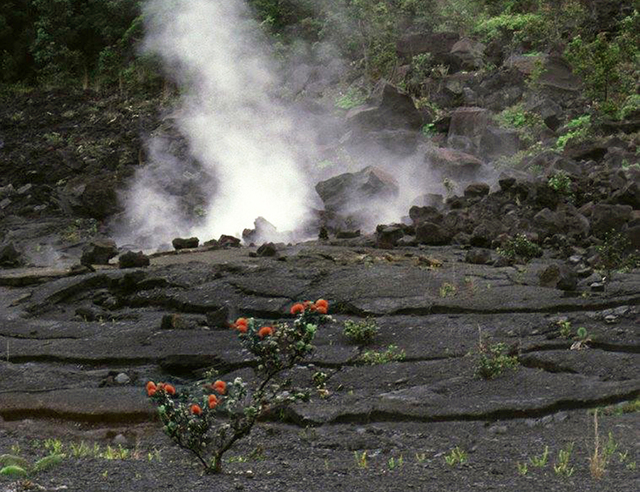One of the wondrous things about visiting a young lava flow on Hawaii Island is encountering the tenacious plant life that emerges from a barren and rough volcanic environment. Volcanophile hikers know that taking a tumble on the sharp, glassy
One of the wondrous things about visiting a young lava flow on Hawaii Island is encountering the tenacious plant life that emerges from a barren and rough volcanic environment. Volcanophile hikers know that taking a tumble on the sharp, glassy lava surface can leave a lasting impression. Yet, within a few years, a recent lava flow can host a community of plants that includes ohia lehua (Metrosideros polymorpha) — one of the most common trees in Hawaii and the first native tree to colonize young lava.
From its humble beginnings on a barren flow, ohia lehua, or ohia, becomes the dominant tree of the Hawaiian rain forest. This keystone species, which holds the entire forest ecosystem together, evolved in complete isolation, and occurs nowhere else in the world. The tree’s original relatives are likely from New Zealand, with the wind-borne seeds making their way to Hawaii by way of the Marquesas Islands.
The ohia tree is adapted to colonize lava flows in an unpredictable volcanic environment. Mature ohia forests always have some flowering trees, so the tiny, light-weight seeds are available year-round to be dispersed to recent flows. The tree has a superior capacity for extending its roots vertically and can grow efficiently in cracks and fissures, taking advantage of residual moisture after rainfall. Ohia also have the capability to close their stomata, or breathing pores, so the trees can “hold their breath” when toxic volcanic gases are blown their way.
Ohia is a tree with immense cultural significance, symbolizing strength, beauty, and sanctity. It is considered the physical manifestation of Ku, one of the four principal Hawaiian deities. The wood was used in sacred structures for heiau (temples) and for weapons and tools. The red, orange and yellow lehua blossoms are a symbol of Pele, the goddess of fire and volcanoes. The ohia is entwined with the art of hula, with its flowers and foliage frequently adorning the dancers and presented as offerings by traditional halau (hula schools).
Unfortunately, there is a new menace threatening this important tree: a fungus, Ceratocystis fimbriata, that is causing a lethal disease in ohia. Known as ohi wilt, or Rapid Ohia Death (ROD), a diseased tree exhibits rapid browning of the leaves on a single limb or in the entire tree crown and typically dies within a matter of weeks. Researchers report that nearly all of the trees in an affected stand will succumb to the disease within two to three years. This has the potential to change the evolution of the volcanic landscape and forest ecosystems in Hawaii, putting our unique Hawaiian birds, invertebrates, plant communities and, potentially, entire watersheds at risk.
Currently, the disease is confined to Hawaii Island. However, it is spreading from the island’s lower Puna and Hilo districts, where it was originally identified, to West Hawaii and Volcano, and has the potential to kill ohia trees statewide.
Since there is no treatment or cure for the disease at this time, the main tactic for managing ROD is to prevent the disease from spreading. In August, the Hawaii Board of Agriculture imposed a quarantine on the intrastate movement of ohia wood and plant parts without a special permit. When visiting or working in Hawaii Island forests, you should treat shoes, gear, tools, vehicles and clothing with a fresh 10 percent bleach solution or greater than 70 percent rubbing alcohol, before moving to another forested area. Most importantly, ohia wood, vegetation or soil should not be moved from its original location.
This winter and holiday season is different than previous ones because of ROD. Residents who use wood to heat their homes should consider that buying ohia firewood may spread ROD to trees in their areas. This year, wreath-making workshops include topics on preventing the spread of ROD, and wreath and lei makers are being encouraged to explore foliage alternatives to ohia.
Next time you pass by an ohia, take a moment to appreciate the pioneer tree that shapes the volcanic landscape in Hawaii. More information and details on preventing the spread of ROD is available on the College of Tropical Agriculture and Human Resources website at www.rapidohiadeath.org and on Facebook at www.facebook.com/RapidOhiaDeath.
Volcano activity updates
Kilauea continues to erupt at its summit and East Rift Zone. The summit lava lake level varied between about 164 and 230 feet below the vent rim within Halemaumau Crater. On the East Rift Zone, scattered lava flow activity remained within about four miles of Puu Oo.
Mauna Loa is not erupting. Small earthquakes continue to occur beneath the volcano’s summit and upper Southwest Rift Zone at rates slightly above background levels. GPS lines across the summit have shown no change, but flank crossing lines continue to extend, which is consistent with inflation of magma reservoirs beneath Mauna Loa.
One earthquake was reported felt on Hawaii Island this past week. On Monday at 10:21 a.m., a magnitude-3.6 earthquake occurred eight and a half miles south of Volcano at a depth of five and four-tenths miles.
Info: www.hvo.wr.usgs.gov, 967-8862 (Kilauea), 967-8866 (Mauna Loa); askHVO@usgs.gov.
Volcano Watch is a weekly article and activity update written by scientists at the U.S. Geological Survey’s Hawaiian Volcano Observatory.



